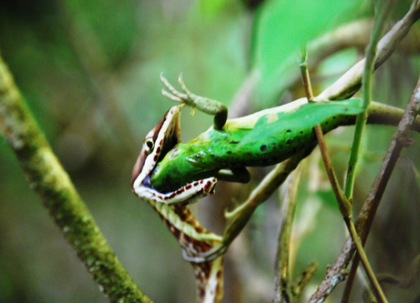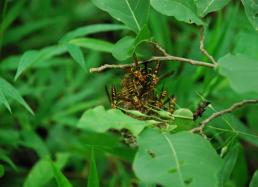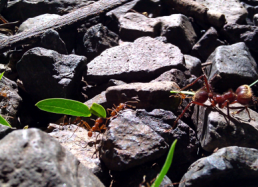Blog #6: The Forest is Very Much Alive
Today is the fourth day of our stay here at the Guanacaste Conservation Area, and we’ve spent the past few days following the trails leading out from the field station. We’ve been in search of several species of acacia ants (there are bountiful acacia tree gardens everywhere) and bullet ants, and we’re working to collect and survey other ant populations that are present in the surrounding areas.
Assigned to keep an eye out for a specific species of generalist acacia ant called Pseudomyrmex gracilis, I was having absolutely no luck on the first and second days. As this is my first foray into fieldwork, I gradually came to realize that my eyes were not yet trained for what to take note of. The first two days, I mostly just noticed the variations in plant growth along different trails, the sounds of the birds, and sometimes a passing deer or two (see Photo #1 below.)
The rest of the team was having much better luck than I, and every few minutes it seemed someone would come across an ant colony, spy an ant of particular interest that was scavenging for food along a branch, or point out other various insects which were known to the area. Frustrated, I continued to try to strain my eyes for any signs of small movement.
Slowly, I noticed a change happening in my awareness. I was no longer straining my eyes, but was indeed detecting smaller and smaller details about my surroundings. Rather than observing the larger landscape, yesterday I realized that I was starting to pick up on features that might serve as shelter for the kinds of things we were looking for. Examples of this include fallen branches, partially buried logs on the ground, the underside of leaves, thorns, hollow twigs, rock ledges, etc.
I slowly started perceiving things like spider webs and wasp nests (see Photo #2 and #3 below) and eventually even tiny burrows in the ground started catching my attention. Before I knew it, the forest suddenly seemed so much more full of life than I had ever before noticed or anticipated.
While just standing still, I could fully take in the spider to my left that was wrapping up its fresh prey, the sweat fly that was hovering in mid-air like a helicopter nearby, the twig-nesting ants transporting their young through the tip of a broken branch above me, the leaf-cutter ants paving a tiny highway across the forest floor, and the colorful beetles mating on the leaf of a nearby shrub (see Photos #4 and #5 below.)
My senses were being sharpened by my surroundings. At one point yesterday, a quick movement jerked my attention to a snake that had just caught a lizard, and was trying to swallow it whole (see above photo.) The realization that something could bring me so fully into the present moment, so fully alive and aware of my surroundings, is creating joy unlike any I've ever known. By the end of today, not only could I recognize acacia ants from a distance, but I was also able to immediately identify the species. The whole experience has been a lot of fun, and feels like a giant, wild, treasure hunt.
More soon,
Arista









